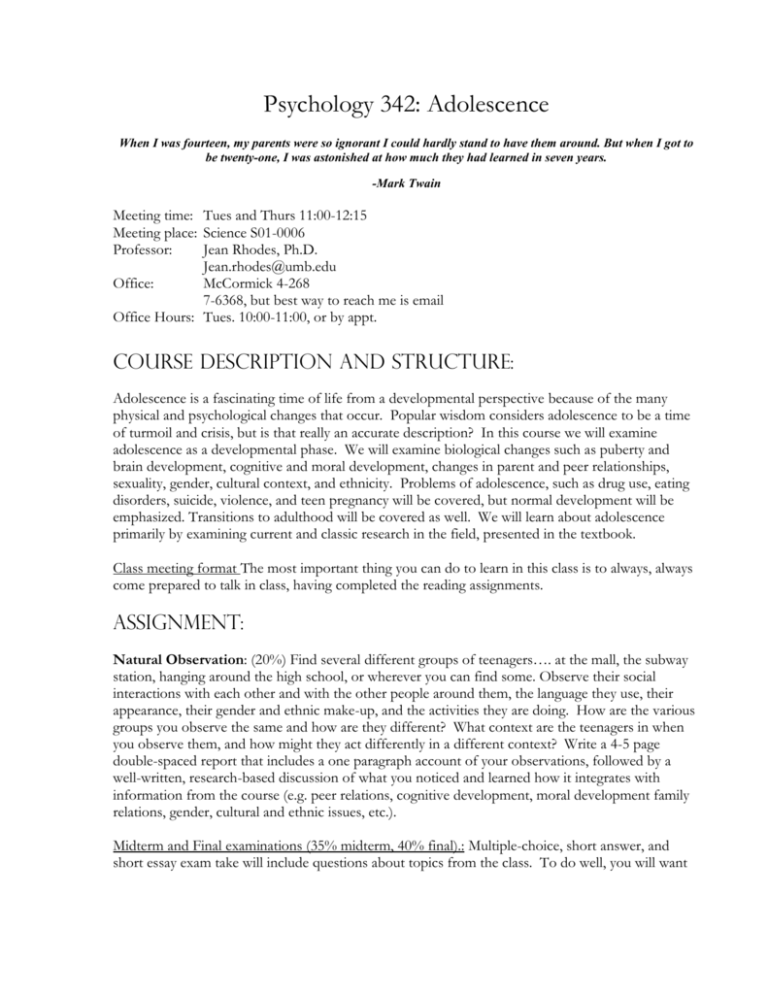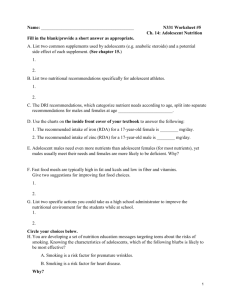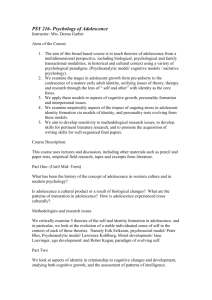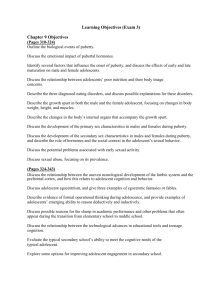Psychology ___ : Adolescent Development
advertisement

Psychology 342: Adolescence When I was fourteen, my parents were so ignorant I could hardly stand to have them around. But when I got to be twenty-one, I was astonished at how much they had learned in seven years. -Mark Twain Meeting time: Tues and Thurs 11:00-12:15 Meeting place: Science S01-0006 Professor: Jean Rhodes, Ph.D. Jean.rhodes@umb.edu Office: McCormick 4-268 7-6368, but best way to reach me is email Office Hours: Tues. 10:00-11:00, or by appt. Course description and structure: Adolescence is a fascinating time of life from a developmental perspective because of the many physical and psychological changes that occur. Popular wisdom considers adolescence to be a time of turmoil and crisis, but is that really an accurate description? In this course we will examine adolescence as a developmental phase. We will examine biological changes such as puberty and brain development, cognitive and moral development, changes in parent and peer relationships, sexuality, gender, cultural context, and ethnicity. Problems of adolescence, such as drug use, eating disorders, suicide, violence, and teen pregnancy will be covered, but normal development will be emphasized. Transitions to adulthood will be covered as well. We will learn about adolescence primarily by examining current and classic research in the field, presented in the textbook. Class meeting format The most important thing you can do to learn in this class is to always, always come prepared to talk in class, having completed the reading assignments. Assignment: Natural Observation: (20%) Find several different groups of teenagers…. at the mall, the subway station, hanging around the high school, or wherever you can find some. Observe their social interactions with each other and with the other people around them, the language they use, their appearance, their gender and ethnic make-up, and the activities they are doing. How are the various groups you observe the same and how are they different? What context are the teenagers in when you observe them, and how might they act differently in a different context? Write a 4-5 page double-spaced report that includes a one paragraph account of your observations, followed by a well-written, research-based discussion of what you noticed and learned how it integrates with information from the course (e.g. peer relations, cognitive development, moral development family relations, gender, cultural and ethnic issues, etc.). Midterm and Final examinations (35% midterm, 40% final).: Multiple-choice, short answer, and short essay exam take will include questions about topics from the class. To do well, you will want Adolescent Development Syllabus to have studied information from class presentations and discussions, from readings, and from your observations. The final is not cumulative Attendance, reading, participation (5%) Come to class every week (on time!), do the assigned reading each week to stay on top of the material, and participate by listen to me and your classmates attentively, asking questions, and contributing meaningful way to the discussions and activities. Late Assignments: If you must miss a deadline for an assignment and turn it in late, your grade will be reduced each day it is late. No exceptions without higher authority. Plagiarism: I require all students to do their own work, to cite references appropriately, and to maintain academic integrity and honesty. Any violations will be reported to the administration of the University of Massachusetts, Boston DISABILITY: If you have a disability and feel you will need accommodations in order to complete course requirements, please contact the Ross Center for Disability Services (Campus Center 2nd Fl., Room 2010) at 617.287.7430. Academic Support (for writing and other assistance) can be obtained through Academic Support Programs, Campus Center 1-1300. Week of: 1. September 2: Overview and theories of adolescence, Chapter 1 Key concepts: What makes adolescents tick? The answer to that question has changed remarkably between the fourth century and today. This course presents key topics that clarify this answer. A theory of adolescent development usually can be attributed to one of four major fundamental schemes: psychoanalytic theory; cognitive theory; learning theory; and ecological, contextual theory. 2. September 9: Puberty, Health, and Biological Foundations, Chapter 2 Key concepts: Biological changes that accompany puberty, hormones, the developmental effects of early and late maturation, changes in sleep patterns at adolescence, and adolescent brain development. How do biological changes that accompany puberty contribute to problems like eating disorders? 3. September 16: The Brain and Cognitive Development, Chapter 3 Key concepts: How is adolescent thought different from that of adults and children? Piaget’s theory of cognitive development, Vygotsky’s theory, and more recent theories. Egocentric thought patterns (such as “imaginary audience” and “personal fable”). 4. September 23: The Self, Identity, Emotions, and Personality, Chapter 4 Key concepts: Erickson’s theory of identity formation and identity crisis. The sense of self in adolescence and “multiple selves”. Is self-esteem likely to plummet in adolescence? What are the developmental effects of high and low self-esteem? How does an adolescent’s ethnicity factor in to his or her development? 2 Adolescent Development Syllabus 5. September 30: Gender, Chapter 5 Key Concepts: What is the effect of gender on development during adolescence? Do boys and girls become more different from each other during the teenage years? How do concepts of masculinity effect boys’ development? 6. October 7: Sexuality, Chapter 6 Key concepts: Teen sexual behavior. Homosexuality in adolescence. Teen pregnancy—it’s causes, effects, and prevention. How effective are teen pregnancy prevention programs? Should birth control be available in high schools? Should sex ed. Classes focus on abstinence? 7. October 14: Moral Development, Civic Engagement, and Religion, Chapter 7 Key concepts: Adolescent moral development: Kohlberg, Gilligan, their criticizers, and prosocial moral development. Adolescent involvement in the political process and the development of religiosity. 8. October 21: MIDTERM (review on Tues.) 9. October 28: Families, Chapter 8 Key concepts: How do adolescents’ relationships with their parents tend to differ from when they were children? What factors are related to the amount of conflict between parents and adolescents and the amount of autonomy that adolescents gain from their parents? How do family structure, different types of parenting, and sibling relationships affect adolescents? 10. November 4: Peer and Romantic Relationships, Chapter 9 Key concepts: Positive and negative peer influences, peer groups, the role of friends, romantic relationships, conformity and non-conformity. Adolescent romantic relationships: their construction, emotions, their function, and their developmental effects. 11. November 11: Schools, Chapter 10 Key concepts: What accounts for high and low achievement, the school culture, learning, dropping out, and part time jobs. How have the recent waves of immigration into this country shaped schools and the adolescent culture? 12. November 18: Achievement, Work, and Careers, Chapter 11 The pace of global change influences adolescents to adapt to societal and academic pressure and to identify strategies for reaching their goals. Adolescents’ efforts to investigate roles for themselves have an ongoing influence and appear to be predictive of later success 13. November 25 Culture and Technology, Chapter 12 NO CLASS ON THURS 3 Adolescent Development Syllabus Socioeconomic status and ethnicity are important dimensions related to culture. Ethnicity and culture have increasingly become a focus of study in adolescent development. School and neighborhoods afford adolescents contact with people from varied cultural and ethnic backgrounds. How has information technology, including IM’s, chat rooms, online dating, etc. transformed adolescence? (Happy Thanksgiving) 14. December 2 Problems in Adolescence and Emerging Adulthood, Chapter 13 Key concepts: What happens when things go wrong in adolescence? How can you tell what is normal teenage behavior and what is a real problem? What factors make some adolescents more likely to rebel? Also, How has the period of early adulthood changed in recent years? The institutions that once served to define adulthood---marriage, childbirth, entry into the workforce--have been transformed by globalization, and shifting patterns of family formation. What does it mean to be an adult? 15. December 9 Health, Stress and coping, Course Review FINAL (TIME TBA) 4







